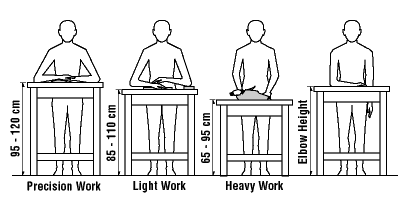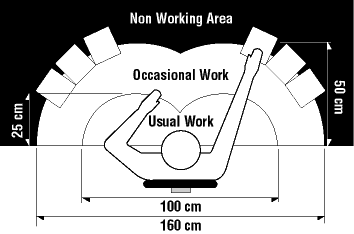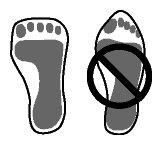Working in a Standing Position - Basic Information
On this page
- Can working in a standing position cause health issues?
- How can working in a standing position be an issue?
- What are some of the health hazards?
- What are some recommendations for improving workplace design?
- How can job design reduce the effects of working in a standing position?
- How can work practices reduce the effects of working in a standing position?
- What is an example of a workstation designed for a standing worker?
- What can workers do to reduce the discomfort of working in a standing position?
- What should workers avoid while working in a standing position?
- What are some do's and don'ts regarding footwear?
- What is recommended regarding floors in a workplace?
Can working in a standing position cause health issues?
Back to topStanding is a natural human posture and by itself poses no particular health hazard. However, working in a standing position on a regular basis can cause sore feet, swelling of the legs, varicose veins, general muscular fatigue, low back pain, stiffness in the neck and shoulders, and other health problems. These are common complaints among sales people, retail workers, machine operators, assembly-line workers and others whose jobs require prolonged standing.
How can working in a standing position be an issue?
Back to topA person's body is affected by the arrangement of the work area and by the tasks that he or she does while standing. The layout of the workstation, the tools, and the placement of keys, controls and displays that the worker needs to operate or observe will determine, and as rule, and restrict body positions that the worker can assume while standing. As a result, the worker has fewer body positions to choose from, and the positions themselves are more rigid. These restrictions give the worker less freedom to move around and less opportunity to alternate which muscles are used. This lack of flexibility in choosing body positions contributes to health problems.
These conditions commonly occur where the job is designed without considering the characteristics of the human body.
What are some of the health hazards?
Back to topKeeping the body in an upright position requires considerable muscular effort. Standing effectively reduces the blood supply to the loaded muscles. Insufficient blood flow accelerates the onset of fatigue and causes discomfort in the muscles of the legs, back and neck (these are the muscles used to maintain an upright position).
The worker suffers not only muscular strain but other discomforts also. Prolonged and frequent standing, without some relief by walking, causes blood to pool in the legs and feet. This pooling may progress over time to chronic and painful varicose veins and inflammation. Excessive standing also causes the joints in the spine, hips, knees, and feet to become temporarily immobilized.
What are some recommendations for improving workplace design?
Back to topIn a well-designed workplace, the worker has the opportunity to choose from among a variety of well-balanced working positions and to change between these positions frequently.
Working tables and benches should be adjustable. Being able to adjust the working height is particularly important to match the workstation to the worker's individual body size and to the worker's particular task. Adjustability ensures that the worker has an opportunity to carry out work in well-balanced body positions. If the workstation cannot be adjusted, platforms to raise the shorter worker or pedestals on top of workstations for the tall worker should be considered.
Organization of the work space is another important aspect. There should be enough room to move around and to change body position. Providing built-in foot rails or portable footrests allows the worker to shift body weight from one leg to the other. Elbow supports for precision work help reduce tension in the upper arms and neck. Controls and tools should be positioned so the worker can reach them easily and without twisting or bending.
Where it is possible, a seat should be provided so that the worker can do the job either sitting or standing. The seat must place the worker at a height that suits the type of work being done. For work that requires standing only, a seat should be provided in any case to allow the worker to sit occasionally. Seats at the workplace expand the variety of possible body positions and give the worker more flexibility.
The benefits from greater flexibility and a variety of body positions are twofold. The number of muscles involved in the work is increased which equalizes the distribution of loads on different parts of the body. Thus, there is less strain on the individual muscles and joints used to maintain the upright position. Changing body positions also improves blood supply to the working muscles. Both effects contribute to the reduction of overall fatigue.
Quality of footwear and type of flooring materials are also major factors contributing to standing comfort. For further details on these subjects, refer to these related documents on OSH Answers:
How can job design reduce the effects of working in a standing position?
Back to topThe basic principles of good job design for standing work are:
- Change working positions frequently so that working in one position is of a reasonably short duration.
- Avoid extreme bending, stretching and twisting.
- Pace work appropriately.
- Allow workers suitable rest periods to relax. Exercise may also help.
- Provide instruction on proper work practices and the use of rest breaks.
- Allow workers an adjustment period when they return to work after an absence for vacation or illness so they can gradually return to a regular work pace.
How can work practices reduce the effects of working in a standing position?
Back to topA well-designed workplace combined with a well-designed job makes it possible to work in a balanced position without unnecessary strain on the body. Although the actual performance of the task depends on the worker (including how the worker stands, moves or lifts), work practices can make the job either safer or more hazardous. Education and training help the individual work safely.
It is important that the worker be informed of health hazards in the workplace. In fact it is a legal requirement. The worker needs to understand which body movements and positions contribute to discomfort and that the conditions causing mild discomfort can lead to chronic injury in the long term. Worker education and training should also contain information on how to adjust specific workplace layouts to the individual's needs.
The worker should be aware that rest periods are important elements of the work. Rest periods should be used to relax when muscles are tired, to move around when muscles are stiff, to walk when work restricts the worker's ability to change postures or positions, and so on. The worker should also be encouraged to report discomforts experienced during work. It may result in correcting working conditions.
All these elements – education, training, and supervision, coupled with active worker input – can result in good work practices. It must be remembered that a well-designed job and workplace are essential to healthy and safe work. Without these, good work practices cannot be effective.
What is an example of a workstation designed for a standing worker?
Back to topWorkplace design should fit the variety of workers' shapes and sizes and provide support for the completion of different tasks.
Different tasks require different work surface heights:
- Precision work, such as writing or electronic assembly – about 5 cm above elbow height; elbow support is needed.
- Light work, such as assembly-line or mechanical jobs – about 5-10 cm below elbow height.
- Heavy work, demanding downward forces – from 20-40 cm below elbow height.

What can workers do to reduce the discomfort of working in a standing position?
Back to top- Adjust the height of the work according to body dimensions, using elbow height as a guide.
- Organize your work so that the usual operations are done within easy reach.

- Always face the object of work.
- Keep body close to the work.
- Adjust the workplace to get enough space to change working position.
- Use a foot rail or portable footrest to shift body weight from both to one or the other leg.
- Use a seat whenever possible while working, or at least when the work process allows for rest.
What should workers avoid while working in a standing position?
Back to top- Avoid reaching behind the shoulder line. Shifting feet to face the object is the recommended way.
- Avoid overreaching beyond the point of comfort.
- Avoid reaching above shoulder line.
What are some do's and don'ts regarding footwear?
Back to topYour feet can only be as comfortable as the footwear permits.
- DO wear shoes that allow the natural shape of your foot.

- DO choose shoes that provide a firm grip for the heel. If the back of the shoe is too wide or too soft, the shoe will slip, causing instability and soreness.
- DO wear shoes that allow freedom to move your toes. Pain and fatigue result if shoes are too narrow or too shallow.
- DO ensure that shoes have arch supports. Lack of arch support causes flattening of the foot.
- DO wear shoes with lace-up fastenings.
- DO tighten the lace instep of your footwear firmly. Lacing prevents the foot from slipping inside the footwear.
- DO choose shoes with padding under the tongue if you suffer from tenderness over the bones at the top of the foot.
- DO use a shock-absorbing cushioned insole when working on metal or cement floors.
- DO choose footwear according to the hazard at your workplace.
- DO select safety footwear, if required, that is CSA approved and carries the proper ratings for the hazard. The OSH Answers document Safety Footwear has additional information.
- DO select footwear taking into account individual fit and comfort. Try them on and walk around for a few moments before buying.
- DO NOT wear shoes that lack arch support or cushioning. A small heel can decrease strain on the Achilles tendon and allow for more comfortable walking and standing.
- DO NOT wear shoes with very high heels. In some situations, a small heel may be useful for traction or to prevent slips (e.g., prevent slips on ladders).
What is recommended regarding floors in a workplace?
Back to top- Keep work areas clean.
- Avoid standing on concrete or metal floors. Recommended for standing work are wooden, cork, or rubber covered floors.
- Ensure that the floors are level and non-slippery.
- Cover concrete or metal floors with mats. Do not introduce new hazards by using mats. Slanted edges on mats help prevent tripping.
- Do not use thick foam-rubber mats. Too much cushioning can cause fatigue and increase the hazard of tripping.
- Fact sheet last revised: 2022-11-30

